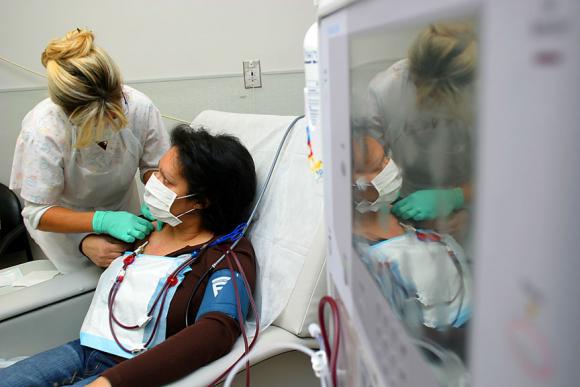PROVIDENCE, R.I. [Brown University] — Amid a presidential campaign and facing the “fiscal cliff,” Americans hear a lot about federal spending, particularly for Medicare. But few probably know of either the history or the present watershed moment in the program’s 40-year struggle to contain costs and finance quality treatment for Americans with end-stage renal disease. In a timely new paper in the September edition of the journal Health Affairs, researchers chronicle the history of how Medicare has provided one of its most costly services, and point out that a new strategy, if successful, could become a fiscal model for the entire program.
In end-stage renal disease, kidney failure leaves dialysis as the only means of survival. It became one of Medicare’s biggest costs after 1972, when the program expanded to care for anyone in the country who needed treatment, regardless of age. Dialysis is expensive and the costs to purchase related anemia drugs is Medicare’s single biggest drug expenditure, amounting to $3.9 billion in 2007.
Last year, after decades of trying to balance cost and quality through traditional financing adjustments, Medicare made considerably more dramatic reforms, write the authors from Brown University and the University of Washington. Now policymakers, health care providers and consumers will see whether Medicare’s simultaneous moves to bundle total costs and discourage lapses in quality will work.

“One of the key and unique aspects of the dialysis reform is the introduction of bundled payments along with pay-for-performance,” said lead author Shailender Swaminathan, assistant professor of health services policy and practice. “The twin payment changes offer a very compelling model of policy reform to rein in health care costs.”
But at the same time, Swaminathan notes, history teaches that Medicare has encountered costs it could not predict or prevent, and there is no consensus about what level of hemoglobin (a metric of anemia and therefore of treatment performance) is right for ESRD patients. Without clear quality goals, bundled payments could drive providers to undertreat patients and that could create more costs elsewhere in the system.
40 years of policy changes
When Medicare began ESRD coverage, the authors wrote, it did so on a fee-for-service basis. Costs surged with enrollment, for instance growing to 64,000 patients at a cost of $1.8 billion — 4 percent of all Medicare spending — in 1982 compared to 16,000 patients at a cost of $229 million in 1973. The number of patients has continued to rise because diabetes and hypertension rates have increased, Swaminathan said, and because improving medical care allows more patients to reach ESRD.
After the first decade, Medicare tried to cap payments for dialysis. Hospital providers received $131 per treatment and clinic providers received $127. For years, providers saw reimbursements drop in inflation-adjusted terms. With payments based on the number of treatment sessions, not their length, the authors wrote, “there was virtually no financial incentive to provide more dialysis.”
In the early 1990s as anemia drugs called erythropoietin stimulating agents (ESAs) came to market, Medicare initially paid on a capitated basis. Economically minded providers responded by giving patients lower doses than recommended: 2,400 units rather than 4,000 units.
Medicare quickly moved to a fee-for-service payment for the ESAs, leading to possible overprescription and the huge rise in costs that made ESAs the program’s most expensive drug. Providers treating the disease, after all, were limited in how much they could make providing dialysis, but unlimited in what they could reap providing ESAs.
“Fee-for-service reimbursement for the use of the agents, coupled with the decline in real value of the composite rate for dialysis, motivated providers to increase their use of the agents,” the authors wrote.
The new regime
Beginning last year, Medicare implemented a new idea to control costs by implementing total bundled payment for providers for dialysis, drugs, and testing. Now providers receive an average of $230 per session for all three.
“In this new payment regime, providers could no longer maximize their Medicare reiumbursements by increasing the use of [ESAs] or other dialysis-related services,” the authors wrote.
Meanwhile they also began imposing penalties on providers whose patients had hemoglobin and urea levels that did not meet standards. But the maximum payment reduction is only 2 percent.
“The pay-for-performance program, which was implemented as a complement to payment bundling, might not independently make a serious dent in total health care costs,” the authors wrote.
The question instead is whether quality will suffer as overall payments are limited with only a mild deterrent to undertreatment, Swaminathan said. “Going forward, the use of ESAs might fall since the FDA has recently removed the requirement that targeted hemoglobin levels in ESRD patients should at least be 10 grams/deciliter,” he said. “This fact plus the incentives provided by bundled payments may see hemoglobin levels decline with a concomitant increase in the rate of blood transfusions, increased hospitalizations and hence increased costs.”
But it is also possible that quality levels will remain high and Medicare will have gained a handle on ESRD costs. What would help, Swaminathan said, is better medical evidence of the best hemoglobin levels to target.
“Then, Medicare may be able to pin their pay-for-performance metrics more closely with the evidence,” he said. “If that is done, the twin pillars of the recent dialysis payment reform — pay-for-performance and bundling — may become successful.”
And then those twin pillars would likely be seen as a model for other services within Medicare, he predicted.
In addition to Swaminathan, the paper’s other authors are Vincent Mor and Amal Trivedi of Brown and the Providence Veterans Affairs Medical Center, and Rajnish Mehrotra of the University of Washington.

